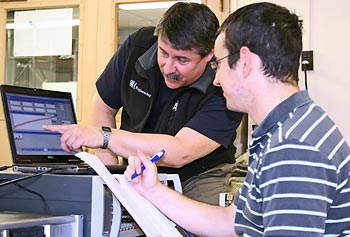Study Will Help Analyze Dynamic Properties of Small Structures

Prof. Peter Avitabile, left, works with a student in his lab.
09/05/2013
By Edwin L. Aguirre
The National Science Foundation (NSF) has awarded a three-year, $500,000 grant to a team of researchers from UMass Lowell and Gustavus Adolphus College in St. Peter, Minn., to study the use of focused ultrasonic radiated force as a mechanism for making tiny structures vibrate. The technique will help determine the structures’ dynamic characteristics without actually touching them.
Applications of this new method include the testing of devices that normally operate in air — such as the armatures in computer hard-disk drives; the small, thumbnail-size turbine blades in jet aircraft engines and the reeds in church organs, to name just a few examples — as well as other devices that normally operate submerged in water or other fluids — such as heart valves and the propellers in naval ships and submarines.
“This work is extremely important in understanding how very small, very lightweight structures behave dynamically at very high frequencies,” says mechanical engineering Prof. Peter Avitabile, who is the principal investigator for the UMass Lowell group.
“Currently, the only way to vibrate structures is by applying force through physical contact, which can dramatically affect the dynamic properties we need to measure,” explains Avitabile, who co-directs the University’s Structural Dynamics and Acoustic Systems Laboratory. “By focusing two ultrasonic beams onto an object, we can make it vibrate without any physical contact.”
In addition to Avitabile, the team members include physics Prof. Thomas Huber of Gustavus Adolphus College as well as mechanical engineering Prof. Christopher Niezrecki and electrical engineering Assoc. Prof. Xingwei Wang of UMass Lowell.
Using optical interferometry and innovative fiber-optic pressure sensors, the researchers will conduct fully non-contact modal testing and analysis over a wide range of structures and frequencies, from below 100 hertz (cycles per second) to more than 200 kilohertz. The resulting data will allow engineers to make structural designs more effective and improve the structures’ dynamic performance. The increased sensitivity of the tests will also assist in detecting defective or damaged components in structures.
The team hopes the NSF project will help move ultrasonic radiated force excitation from being a strictly laboratory technique into a methodology that can be widely adopted by the engineering community.
